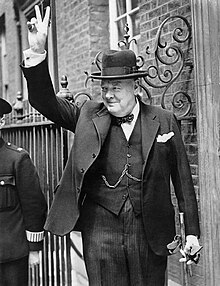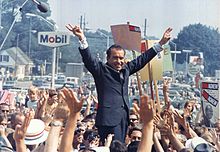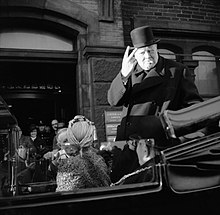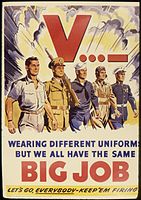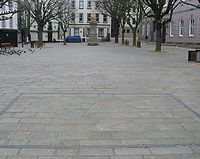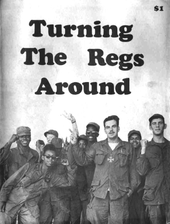
A salute is usually a formal hand gesture or other action used to display respect in military situations. Salutes are primarily associated with the military and law enforcement, but many civilian organizations, such as Girl Guides, Boy Scouts and the Salvation Army use formal salutes. Ordinary civilians also salute informally to greet or acknowledge the presence of another person, such as a tip of the hat or a hand wave to a friend or neighbor.

In Western culture, "the finger", or the middle finger also represented as "🖕" is an obscene hand gesture. The gesture communicates moderate to extreme contempt, and is roughly equivalent in meaning to "fuck you", "fuck me", "shove it up your ass/arse", "up yours", or "go fuck yourself". It is performed by showing the back of a hand that has only the middle finger extended upwards, though in some locales, the thumb is extended. Extending the finger is considered a symbol of contempt in several cultures, especially in the Western world. Many cultures use similar gestures to display their disrespect, although others use it to express pointing without intentional disrespect. The gesture is usually used to express contempt but can also be used humorously or playfully.

The Roman salute, is a gesture in which the right arm is fully extended, facing forward, with palm down and fingers touching. In some versions, the arm is raised upward at an angle; in others, it is held out parallel to the ground. In contemporary times, the former is commonly considered a symbol of fascism that had been based on a custom popularly attributed to ancient Rome. However, no Roman text gives this description, and the Roman works of art that display salutational gestures bear little resemblance to the modern Roman salute.

A mudra is a symbolic or ritual gesture or pose in Hinduism, Jainism and Buddhism. While some mudras involve the entire body, most are performed with the hands and fingers.

The Vulcan salute is a hand gesture popularized by the 1960s television series Star Trek. It consists of a raised hand with the palm forward and the thumb extended, while the fingers are parted between the middle and ring finger. The gesture was devised by Star Trek actor Leonard Nimoy as a salute for the alien Vulcan species, and is popular within the Science fiction fandom and nerd culture. The blessing phrase "live long and prosper" is frequently spoken alongside it.

The raised fist, or the clenched fist, is a long-standing image of mixed meaning, often a symbol of solidarity, especially with a political movement. It is a common symbol representing a wide range of political ideologies, most notably socialism, communism, anarchism, and trade unionism, and can also be used as a salute expressing unity, strength, or resistance.
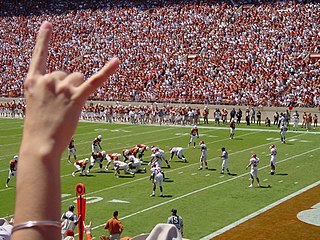
Hook 'em Horns is the chant and hand signal of The University of Texas at Austin. Students, alumni, and fans of the university employ a greeting consisting of the phrase "Hook 'em" or "Hook 'em Horns" and also use the phrase as a parting good-bye or as the closing line in a letter or story.

The OK gesture or OK sign or ring gesture is performed by joining the thumb and index finger in a circle, and holding the other fingers straight or relaxed away from the palm. Commonly used by scuba divers, it signifies "I am OK" or "Are you OK?" when underwater. In most English-speaking countries it denotes approval, agreement, and that all is well or "okay". In other contexts or cultures, similar gestures may have different meanings including those that are negative, offensive, financial, numerical, devotional, political, or purely linguistic.
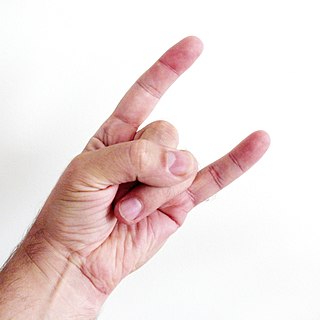
The sign of the horns is a hand gesture with a variety of meanings and uses in various cultures. It is formed by extending the index and little fingers while holding the middle and ring fingers down with the thumb.

The three-finger salute ; or three fingers,, commonly known as the Serbian salute, is a salute which the thumb, index, and middle finger are extending. It originally expressed the Holy Trinity, used in oath-taking, and a symbol of Serbian Orthodoxy, while today simply is a gesture, distinctive sign for the ethnic Serb and a symbol for belonging to the Serbian nation.
A taunt is a battle cry, sarcastic remark, gesture, or insult intended to demoralize the recipient, or to anger them and encourage reactionary behaviors without thinking. Taunting can exist as a form of social competition to gain control of the target's cultural capital. In sociological theory, the control of the three social capitals is used to produce an advantage in the social hierarchy, so as to enforce one's own position in relation to others. Taunting is committed by either directly or indirectly encouraging others to taunt the target. The target may give a response in kind to maintain status, as in fighting words and trash-talk.

A mountza or moutza also called faskeloma is the most traditional gesture of insult among Greeks. It consists of extending and spreading all fingers of the hand and presenting the palm towards the face of the person to be insulted with a forward motion.

Victor Auguste de Laveleye was a Belgian liberal politician and minister. He also served as announcer on Radio Belgique during World War II.

A bras d'honneur, Iberian slap, forearm jerk, Italian salute, or Kozakiewicz's gesture, is an obscene gesture that communicates moderate to extreme contempt, and is roughly equivalent in meaning to "fuck you" or "up yours", having the same meaning as giving the finger. To make the gesture, an arm is bent in an L-shape, with the fist pointing upwards; the other hand then grips or slaps the biceps of the bent arm as it is emphatically raised to a vertical position.

The fig sign is a mildly obscene gesture that uses a thumb wedged in between two fingers. The gesture is most commonly used to ward off the evil eye, insult someone, or deny a request. It has been used at least since the Roman Age in Southern Europe and parts of the Mediterranean region, including in Turkish culture. Some countries in Asia, Slavic cultures and South Africa use it too. It is used playfully in Northwestern Europe and North Africa, countries such as the US, Canada, Australia, Libya, Tunisia and Czech Republic to pretend to take the nose off a child.
An obscene gesture is a movement or position of the body, especially of the hands or arms, that is considered exceedingly offensive or vulgar in some particular cultures. Such gestures are often sexually suggestive.

The Nazi salute, also known as the Hitler salute, or the Sieg Heil salute, is a gesture that was used as a greeting in Nazi Germany. The salute is performed by extending the right arm from the shoulder into the air with a straightened hand. Usually, the person offering the salute would say "Heil Hitler!", "Heil, mein Führer!", or "Sieg Heil!". It was officially adopted by the Nazi Party in 1926, although it had been used within the party as early as 1921, to signal obedience to the party's leader, Adolf Hitler, and to glorify the German nation. The salute was mandatory for civilians but mostly optional for military personnel, who retained a traditional military salute until the failed assassination attempt on Hitler on 20 July 1944.
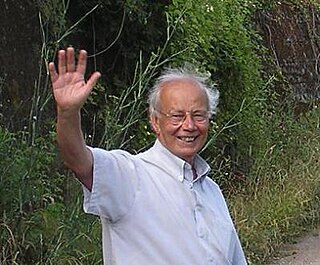
Waving is a nonverbal communication gesture that consists of the movement of the hand and/or entire arm that people commonly use to greet each other, but it can also be used to say goodbye, acknowledge another's presence, call for silence, or deny someone. The wave gesture is an essential element of human language.

The three-finger salute is a hand gesture made by raising the index, middle and ring fingers, while holding the thumb to the little finger, and raising the hand with the palm facing out in a salute. The gesture was popularized in the 2010s after its use in The Hunger Games as a symbol of revolution. The gesture has been adopted by protesters, particularly for pro-democracy protest movements in Southeast Asia, mainly in Thailand and Myanmar, as well as in other countries, including Hong Kong.
